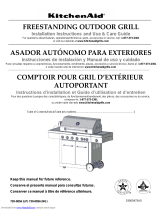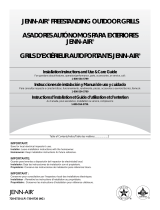
TABLE OF CONTENTS
OUTDOOR GRILL SAFETY............................................................3
INSTALLATION REQUIREMENTS................................................5
Tools and Parts ............................................................................5
Location Requirements................................................................5
Product Dimensions ....................................................................6
Gas Supply Requirements...........................................................6
Gas Connection Requirements....................................................7
INSTALLATION INSTRUCTIONS..................................................8
Freestanding Outdoor Grill Installation........................................8
Make Gas Connection .................................................................9
GAS CONVERSIONS....................................................................11
Tools and Parts for Gas Conversion..........................................11
Conversion from LP Gas to Natural Gas ...................................11
Check and Adjust the Burners...................................................14
OUTDOOR GRILL USE ................................................................15
Using Your Outdoor Grill............................................................15
Using Your Infrared Sear Burner................................................17
TIPS FOR OUTDOOR GRILLING ................................................18
Cooking Methods.......................................................................18
Grilling Chart...............................................................................19
OUTDOOR GRILL CARE .............................................................21
Replacing the Igniter Battery .....................................................21
General Cleaning........................................................................21
TROUBLESHOOTING ..................................................................23
ASSISTANCE ................................................................................23
REPLACEMENT PARTS ..............................................................24
WARRANTY ..................................................................................26
ÍNDICE
SEGURIDAD DEL ASADOR PARA EXTERIORES.....................29
REQUISITOS DE INSTALACIÓN.................................................31
Herramientas y piezas................................................................31
Requisitos de ubicación.............................................................31
Medidas del producto................................................................32
Requisitos del suministro de gas...............................................32
Requisitos para la conexión de gas...........................................33
INSTRUCCIONES DE INSTALACIÓN.........................................34
Instalación del asador autónomo para exteriores .....................34
Conexión del suministro de gas ................................................35
CONVERSIONES DE GAS ...........................................................37
Herramientas y piezas para la conversión de gas.....................37
Conversión de gas LP a gas natural..........................................37
Revise y regule los quemadores................................................41
USO DEL ASADOR PARA EXTERIORES ...................................42
Cómo usar el asador para exteriores.........................................42
Uso del quemador infrarrojo para dorado rápido......................44
CONSEJOS PARA ASAR AL AIRE LIBRE..................................45
Métodos de cocción ..................................................................45
Cuadro para asar........................................................................46
CUIDADO DEL ASADOR PARA EXTERIORES..........................49
Cómo reemplazar la batería del encendedor ............................49
Limpieza general ........................................................................49
SOLUCIÓN DE PROBLEMAS......................................................51
ASISTENCIA..................................................................................51
PIEZAS DE REPUESTO ...............................................................52
GARANTÍA.....................................................................................54
TABLE DES MATIÈRES
SÉCURITÉ DU GRIL D'EXTÉRIEUR ...........................................56
EXIGENCES D’INSTALLATION...................................................58
Outils et pièces...........................................................................58
Exigences d'emplacement.........................................................58
Dimensions du produit...............................................................59
Spécifications de l'alimentation en gaz .....................................59
Exigences concernant le raccordement au gaz ........................60
INSTRUCTIONS D’INSTALLATION.............................................61
Installation du gril d’extérieur autoportant.................................61
Raccordement au gaz................................................................62
CONVERSIONS POUR CHANGEMENT DE GAZ.......................64
Outils et pièces pour conversion de gaz ...................................64
Conversion de propane à gaz naturel........................................64
Contrôle et réglage des brûleurs................................................68
UTILISATION DU GRIL D’EXTÉRIEUR.......................................69
Utilisation du gril d’extérieur.......................................................69
Utilisation du brûleur infrarouge à rôtissage..............................71
CONSEILS POUR L'UTILISATION DU GRIL D'EXTÉRIEUR ...72
Méthodes de cuisson.................................................................72
Tableau de cuisson au gril .........................................................73
ENTRETIEN DU GRIL D’EXTÉRIEUR .........................................76
Remplacement de la pile de l’allumeur......................................76
Nettoyage général ......................................................................76
DÉPANNAGE.................................................................................78
ASSISTANCE ................................................................................79
PIÈCES DE RECHANGE ..............................................................80
GARANTIE.....................................................................................82






















